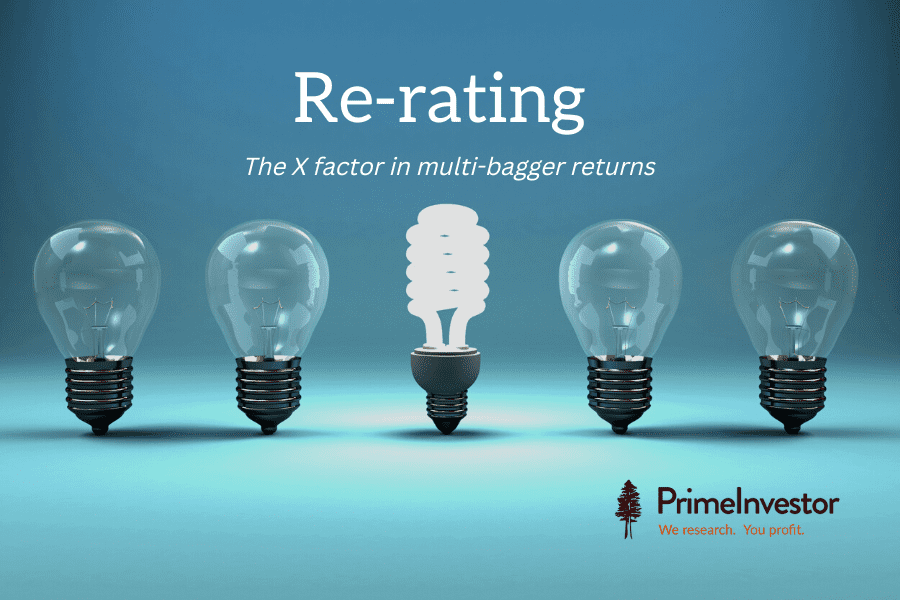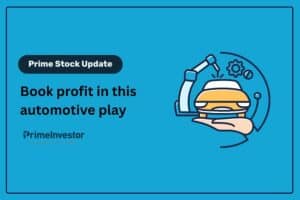Ask any new CFA pass-out what drives stock returns in the long run and he’ll likely tell you that it is earnings, of course! Equity analysts spend many man (and woman) hours on excel sheets, trying to model the future earnings of companies, to identify stocks to bet on.
But if you look at the journey of multi-bagger stocks over any time period, you’ll find that there’s an X factor apart from earnings that drives multi-bagger returns.

Look at the table below, which captures the top 25 multi-baggers of the past decade (from November 2012 to November 2022). It shows that all of these companies managed high profit growth between 2012 and 2022.
But an equally important factor in their stellar stock price returns is the re-rating in their PE multiple. Re-rating, a term used for the market deciding to award a stock a much higher valuation multiple, is the factor that transforms some stocks into Usain Bolts, while others remain also-rans.
Understanding what contributes to stocks getting re-rated by the market is therefore as important to identifying multi-baggers as poring over excel sheets. So how can you, as an equity investor, identify stocks that may be candidates for PE re-rating? Based on past examples, here are the triggers to look for.
Margin transition
When analysts screen for ‘quality’ companies to invest in, a key metric they look for is a high operating profit margin (OPM). A high OPM is a sign that the company enjoys a wide ‘moat’ - the ability to charge its customers a sizeable mark-up over costs, irrespective of economic or business cycles. Moats are a holy grail for equity investors; therefore, companies which manage to move their OPMs into a higher orbit on a sustainable basis are often candidates for a big re-rating.
FMCG company Marico is a good example. Its stock, which hovered below Rs 100 until March 2014 suddenly gained speed to treble over the next 4 years. This was the result mainly of the company’s PE expanding from 30 times to nearly 60 times in this period.
The metric that saw dramatic improvement from FY14 onwards was its OPM, which moved from 12-14% until FY13, to 20% by FY17. The margin improvement, which has sustained since then, was the result of strategic efforts by Marico to change its product mix from high-penetration, low-margin FMCG products such as cooking oil and coconut oil to high-growth premium products such as ready-to-cook, wellness and beauty products and men’s grooming. The OPM improvements helped net profits zoom from Rs 504 crore in FY14 to Rs 811 crore by FY17, a 60% jump even as its revenues expanded by just 26%
Companies can move their OPMs into a higher orbit through other means too – say, acquisition of brands or facilities through the inorganic route and forward or backward integration.
Execution prowess
In India, there is no dearth of managements of small companies that dream big and build manufacturing capacities in the air. However, most small-sized companies fail to scale up beyond a Rs 500 crore size as they lack the ability to make the right capital allocation decisions and execute projects on the ground. This makes the market look very favourably on companies that do manage to scale their business through value-adding new product forays and timely execution of capex.
Deepak Nitrite is a good example of a company which has managed to dramatically alter the market’s perception of the business, through relentless capex and forays into new products that have de-risked its business and lifted margins. A maker of commodity chemicals such as nitric acid and its derivatives used mainly in chemical, textile and fertiliser industries, Deepak Nitrite traded in a modest PE band of 10-20 times until FY17.
But the company re-organised itself into three distinct strategic business units and embarked on a furious pace of capex from 2013. Focusing on import substitute products, it commissioned large capacities for optical brightening agents, phenol and acetone between 2014 and 2019. It followed this up with a host of downstream projects that have added pharma, adhesive, paint, thinner and FMCG makers to its client base, taking its user industries to 50. During Covid, these additions helped it cater to the surge in demand for sanitizers. The capex spree has lifted OPMs and catalysed a tenfold increase in profits in 5 years.
This journey has won the stock a dramatic re-rating, from a PE of 10-20 times fifteen years ago to 50-70 times now, and ensured a stock CAGR of 56%. Many of the chemical and intermediate manufacturers who figure in the above multi-baggers list - be it Alkyl Amines, or SRF or Bharat Rasayan - owe their re-rating to similar stories of executing new projects in the right verticals.
From cyclical to secular
Predictability is a rare quality in the uncertain world of equity investing. This makes markets willing to pay a valuation premium for companies that deliver predictable growth in their profits, as opposed to those whose profits swing up and down with business cycles.
Companies that manage to transition their cyclical business into one with secular growth are often ripe candidates for a PE re-rating. A good example of this is Carborundum Universal, which has seen its stock price deliver a 19% CAGR over ten years while its profits have compounded at just 4%. The company which used to be a supplier of abrasives and ceramics to manufacturing has managed to smooth out the cyclicality in earnings by substantially widening its range of products and diversifying into the US, Australian, South African and Russian markets through expansion and acquisitions. (Read a detailed account of this capital goods stock here)
The less-cyclical earnings have attracted the market’s notice and the company’s PE, which used to be stuck in the 15-25 band until 2013 has been re-rated to 40-50 times. Its financial metrics show no exceptional growth in this period, with revenues growing 5% CAGR in the last ten years while profits after tax have managed 4%. The table below shows how CUMI’s earnings have charted a steady growth path since FY16 in contrast to the zig-zag nature before.
New addressable markets
Being incurable optimists, equity investors like to bet on potential. The larger the market opportunity a company faces, the higher the PE it enjoys. Therefore, when a company operating in a mature sector turns its sights to a new sunrise sector with high growth or profit potential, the market gets fired up to re-rate the stock.
A recent example of this lies in the Tata Consumer Products (TCPL) stock. As a maker and marketer of boring FMCG products such as tea and mineral water, Tata Global Beverages did not enjoy much market favour. Not only was the tea business low-margin, the company also went on an overseas acquisition spree to buy up UK-based Tetley Tea and Eight O Clock Coffee at the turn of the millennium which added big debt to its balance sheet. Between FY12 and FY19, while the company’s revenues grew by 9% in absolute terms its profits zig-zagged, with some loss-making years.
But 2019-20 saw the company get a substantial makeover, with the Tata group deciding to house all its food and consumer businesses in it. The consumer business of Tata Chemicals has been merged into the company, which has been renamed TCPL and recently the merger proposal of Tata Coffee has been approved. With branded staples such as pulses and spices gaining ground during Covid, Tata Sampann staples and Soulfull packaged food have opened up promising new addressable markets for TCPL, beyond tea and salt, with rising shares in e-commerce and modern retail channels.
Thanks to these moves, TCPL’s revenues have scaled up from Rs 7,252 crore in FY19 to Rs 12,425 crore in FY22, while its profits have gone from Rs 457 to Rs 1,017 crore. Though many of TCPL’s food forays are recent, the market has already bought into a new growth script, re-rating the stock from 30-40 times earnings to over 70-100 times in the past year. This has led to the stock price zooming 38% in 3 years.
Change in sector perception
While thus far we have seen company-specific cases of re-rating, a more common occurrence is the market bidding up the PE multiple of an entire sector because its perception of it has undergone a sea change.
A striking example of this is the auto ancillary industry in the last three years. Most auto ancillary stocks were battered ruthlessly in 2020, as investors took a doomsday view of their prospects after the advent of electric vehicles. With the government erecting multiple regulatory roadblocks in the way of conventional vehicles and making a big push for EVs, markets significantly de-rated not just auto OEMs but also their ancillary suppliers.
But subsequent data has shown this pessimism to be overdone. Leading auto ancillary players have in fact been preparing well ahead for the EV transition by upgrading their manufacturing capabilities from simple casting, forging or sheet metal parts to more sophisticated solutions that enhance passenger comfort, convenience or safety or cater to the ancillary needs of new-age EV vehicles.
Uno Minda (Minda Industries), for example, managed to evolve from being a supplier of switches, lamps and horns to automobile-makers to a supplier of high-end acoustics, lighting, security, alloy wheel and telematics solutions. A combination of inorganic acquisitions and greenfield expansion have helped this transition. The stock’s 55% CAGR in the last ten years has been propped up by its PE expanding from a modest 11-12 times ten years ago to 50-60 times. Multi-baggers such as JBM Auto, Bharat Forge, Lumax also have a similar story to relate, of markets over-estimating business risks from the EV transition, only to have the company overcome them.
However, investors looking for multi-bagger ideas need to be a bit wary of entire sectors that suddenly enjoy a PE re-rating. For every sector that has enjoyed a re-rating with good fundamental reasons, there are many that get re-rated on the back of fanciful themes or big picture ideas without any improvements in the underlying fundamentals. In such cases, where earnings fail to catch up with the exalted PE multiples, big stock price reverses are bound to follow. The re-rating of PE multiples for paint and building material stocks prior to Covid, or the sudden fancy for diagnostic chains or makers of specific drugs during Covid are examples of re-rating that hasn’t sustained.
Takeaways for multi-bagger returns
To summarise all that has been discussed above:
- To identify multi-bagger stocks, it is not enough to identify companies with good earnings prospects. You need to gauge if the stock has potential for PE re-rating.
- A low starting PE for a company or sector owing to undue pessimism creates greater potential for re-rating.
- The triggers for PE re-rating for individual companies usually come from: one - shift to a superior product mix, two - entry into new addressable market with better growth/margins, three - strong execution of capex or inorganic growth, four - transition from cyclical to secular growth business, or five - de-risking of portfolio through diversification, forward or backward integration
- For significant gains from re-rating, you need to identify such shifts early in the cycle and begin to build positions.
- Don’t get misled by managements talking big, look for on-ground changes in capacities, revenues, margins.
- PE re-rating can sometimes lift up entire sectors, but beware of re-rating driven by transitory market opportunities or earnings boosts
- Be wary of big picture narratives such as Digital India, China Plus One, PLIs, Financialisation etc that are used to drive up PEs of entire sectors without getting into micro details of how individual companies will benefit
- Be wary of entering stocks that have amassed much of their returns from PE re-rating rather than earnings expansion








5 thoughts on “Re-rating: The X factor in multi-bagger returns”
Very nice Article, Thanks. small correction to be made in the first table? -> PE Nov 2012 instead of PE Nov 2021.
Yes sorry will correct it.
Nice articles and very well articulated thoughts by Aarti. My observation if we add two other parameters- ROCE and ROE, the probability of going wrong is low and good returns possibility high. A high ROCE and ROE is one of the reason for Nifty trading at a huge premium (P/E) to other markets as Nifty companies is have high returns ratios wrt to other countries index components . Suggest if such an article is also written to highlight the myth created by Broking firms of high valuation of Indian markets just based on P/E and ignoring ROCE and ROE
Good article, Aarati. Would be useful to understand if some MF Managers have had proven success on playing these learnings. Infact are quant funds able to play these better? For lay individuals, it is more difficult to get an overall portfolio return which is strong.
Have seen many successful active managers like Sankaran Naren, Neelesh Surana spot such stocks. Quant typically would not get into these stocks early in rerating cycle and may hop on only after bulk of it is done!
Comments are closed.